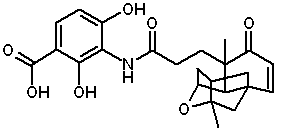Platensimycin inhibits fatty-acid synthesis

|
|
structure of platensimycin
|
Modern medicine triumphantly introduced antibiotics in the treatment scheme of infections by microorganisms. The microorganisms however felt threatened for life and consequently developed defence strategies termed resistance. So medical professionals (with the help of scientists) always look for new antibiotics which they hope the microorganisms can't cope with.
Platensimycin is a natural compound produced by Streptomyces platensis. It was discovered in a huge screening effort aimed at bacterial fatty-acid biosynthesis. Platensimycin was found to bind to the condensing enzyme FabF used in the type II fatty-acid synthesis elongation step.
In a mouse model infections with multiresistant streptococci could be cured; gram-negative bacteria were not affected. So there may be hope for treatment of some serious human illnesses too.
|
platensimycin bound to FabF |
| To confirm the inhibition mechanism the target enzyme of platensimycin was crystallized with various ligands and the structures determined by X-ray methods. The models resulting from these investigations are demonstrated in the script on FabF, the elongation condensing enzyme in fatty acid biosynthesis. |
Experimental details:
J Wang et al, Nature 441 (2006) 358-361 |
9-06 © Rolf Bergmann